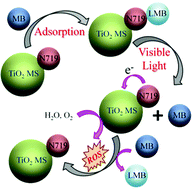Heterodimerization at the dye sensitized TiO2 surface: an efficient strategy toward quick removal of water contaminants
Abstract
Sensitization of wide bandgap semiconductors with heterodimers for better solar light sensitivity has attracted widespread attention in the recent times. However, application of heterodimerization for removing soluble water pollutants from waste water is sparse in the literature. In the present study, we have utilized heterodimerization of a model pollutant methylene blue (MB) with a ruthenium based dye N719 for the removal of the pollutant. We have synthesized N719 functionalized carbonate doped TiO2 microspheres (doped MS) which act as a novel material for the detoxification of MB containing water by adsorbing at the surface and eventually killing by photoinduced reduction under visible light irradiation. The mechanism of surface adsorption and photoreduction of MB are explored using steady state and time resolved spectroscopy studies. We have fabricated two types of prototype devices (flow device and active filter) using the functionalized doped MS. Both the devices show excellent dye removal activity and recyclability. The present study would find relevance in the removal of soluble pollutants from waste water.


 Please wait while we load your content...
Please wait while we load your content...